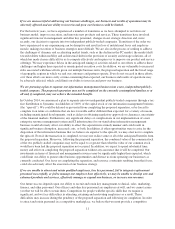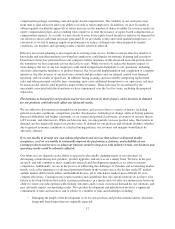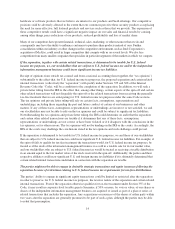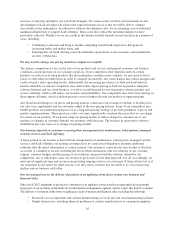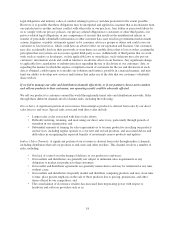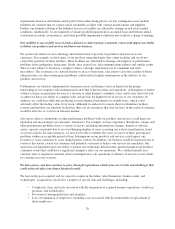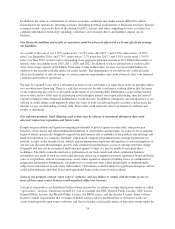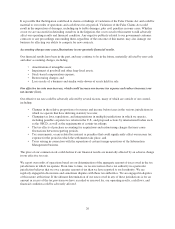Symantec 2015 Annual Report Download - page 94
Download and view the complete annual report
Please find page 94 of the 2015 Symantec annual report below. You can navigate through the pages in the report by either clicking on the pages listed below, or by using the keyword search tool below to find specific information within the annual report.resources to develop and deploy our own SaaS strategies. We cannot assure you that our investments in and
development of SaaS offerings will achieve the expected returns for us or that we will be able to compete
successfully in the marketplace. In addition to software development costs, we are incurring costs to build and
maintain infrastructure to support SaaS offerings. These costs may reduce the operating margins we have
previously achieved. Whether we are successful in this business model depends on our execution in a number of
areas, including:
• Continuing to innovate and bring to market compelling cloud-based experiences that generate
increasing traffic and market share; and
• Ensuring that our SaaS offerings meet the reliability expectations of our customers and maintain the
security of their data.
We may need to change our pricing models to compete successfully.
The intense competition we face in the sales of our products and services and general economic and business
conditions can put pressure on us to change our prices. If our competitors offer deep discounts on certain
products or services or develop products that the marketplace considers more valuable, we may need to lower
prices or offer other favorable terms in order to compete successfully. Any such changes may reduce margins and
could adversely affect operating results. Additionally, the increasing prevalence of cloud and SaaS delivery
models offered by us and our competitors may unfavorably impact pricing in both our on-premise enterprise
software business and our cloud business, as well as overall demand for our on-premise software product and
service offerings, which could reduce our revenues and profitability. Our competitors may offer lower pricing on
their support offerings, which could put pressure on us to further discount our product or support pricing.
Any broad-based change to our prices and pricing policies could cause our revenues to decline or be delayed as
our sales force implements and our customers adjust to the new pricing policies. Some of our competitors may
bundle products for promotional purposes or as a long-term pricing strategy or provide guarantees of prices and
product implementations. These practices could, over time, significantly constrain the prices that we can charge
for certain of our products. If we do not adapt our pricing models to reflect changes in customer use of our
products or changes in customer demand, our revenues could decrease. The increase in open source software
distribution may also cause us to change our pricing models.
Our business depends on customers renewing their arrangements for maintenance, subscriptions, managed
security services and SaaS offerings.
A large portion of our revenue is derived from arrangements for maintenance, subscriptions, managed security
services and SaaS offerings, yet existing customers have no contractual obligation to purchase additional
solutions after the initial subscription or contract period. Our customers’ renewal rates may decline or fluctuate
as a result of a number of factors, including the level of their satisfaction with our solutions or our customer
support, customer budgets and the pricing of our solutions compared with the solutions offered by our
competitors, any of which may cause our revenue to grow more slowly than expected, if at all. Accordingly, we
must invest significant time and resources in providing ongoing value to our customers. If these efforts fail, or if
our customers do not renew for other reasons, or if they renew on terms less favorable to us, our revenue may
decline and our business will suffer.
Our increasing focus on the delivery of products in an appliance form factor creates new business and
financial risks.
Since fiscal 2012, shipments of products to customers in an appliance form factor have represented an increasingly
larger part of our revenues, particularly in our information management segment, and we expect this trend to continue.
The delivery of solutions in the form of appliances creates business and financial risks, including the following:
• Increased cost of components and contract manufacturing, as we do not own our manufacturing facilities;
• Supply chain issues, including financial problems of contract manufacturers or component suppliers;
16







